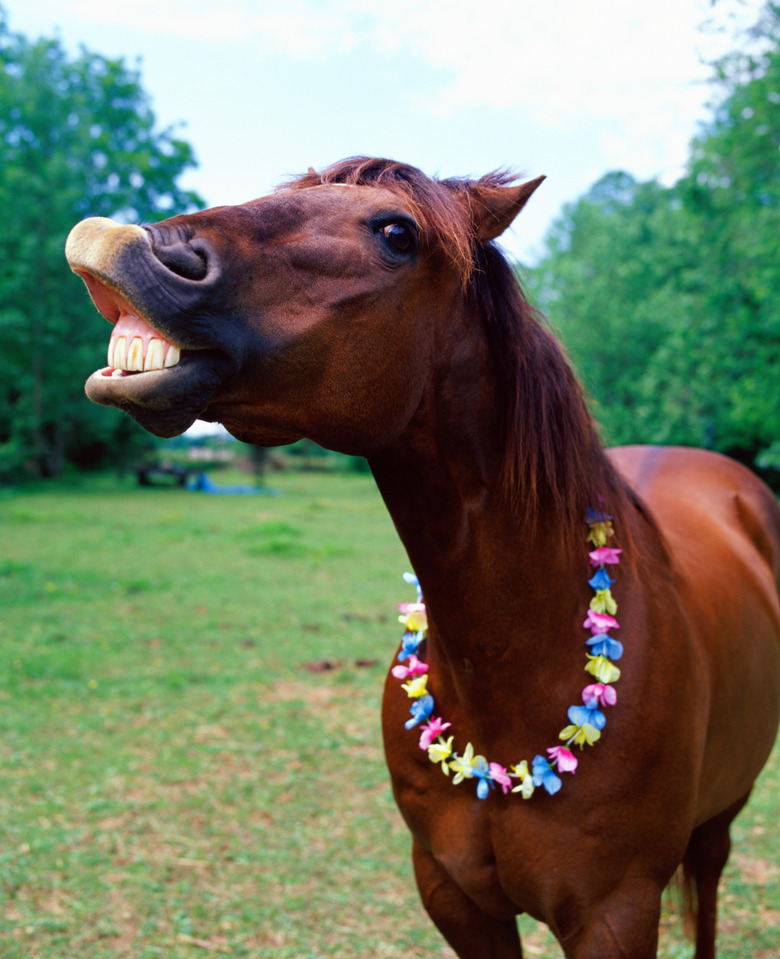What Is The Genotype For The Roan Color?
Gregor Mendel's genetic studies focused on peas. Genes in pea plants exhibit straightforward dominant and recessive traits based on inheritance of a single pair of genes.
Not all traits, however, depend on single gene pairs and not all gene pairs exhibit the dominant and recessive pattern Mendel documented. Non-Mendelian inheritance patterns cause interesting outcomes like the blue cow.
Genetics Vocabulary
Genetics Vocabulary
Traits are inherited characteristics, whether dominant or recessive. Traits move from generation to generation via genes. Genes for Mendelian traits have either dominant or recessive alleles. An allele is a variation of a gene for a trait.
For example, eye color in humans includes the gene variations, or alleles, for brown eyes and blue eyes. The allele for brown eyes dominates the recessive allele for blue eyes, if all other factors remain consistent. The gene allele for blue eyes remains in the genetic code, but the child inheriting alleles for both brown and blue eyes will usually exhibit brown eyes.
Heterozygous Organisms
Heterozygous Organisms
Hybrid or heterozygous organisms carry two different alleles for a trait. Homozygous organisms carry the same alleles for a trait. An organism's genotype describes the gene combination the organism inherited.
An organism's phenotype can be seen in the physical expression of the genotype. The child with genes for brown eyes and blue eyes can be described as a heterozygous offspring with brown-eyed, blue-eyed genotype and brown-eyed phenotype.
Non-Mendelian Inheritance Patterns
Non-Mendelian Inheritance Patterns
Not all inheritance patterns follow the Mendelian pattern, however. Non-Mendelian inheritance patterns result in outcomes different from those predicted by Mendel's work. There are several different kinds of non-Mendelian inheritance.
Codominant Traits
Codominant traits occur when both alleles express themselves in the offspring's phenotype. For example, human blood types A and B are codominant. An offspring inheriting the genes for blood type A and blood type B will have blood type AB. Blood types are labeled A, B and O, with A and B being codominant and type O recessive to both A and B.
In chickens, the offspring of a white chicken and a black chicken will have white feathers and black feathers rather than all white, all black, or gray feathers. Genotypes of codominant traits use the letter i with a superscript representing the alleles. The genotype for the chickens would be written as iWiB.
Incomplete Dominant Traits
Incomplete dominant alleles blend rather than mask.
For example, snap dragons and carnations demonstrate incomplete dominance. Purebred red carnations crossed with purebred white carnations result in hybrid pink carnations.
Incomplete dominant alleles are represented by different capital letters, like RW to represent the genotype for the pink carnations.
Polygenic Traits
Multiple genes control inheritance and expression of polygenic traits. Polygenic traits include eye, skin and hair color as well as height (environmental factors like nutrition also impact height).
Sex-Linked Traits
Certain traits can be inherited from either parent but depend on gender to express the phenotype. For example, sex-limited traits such as heavy facial hair like beards and mustaches expresses in men even though men and women both inherit for genes for facial hair.
Inherited sex-controlled genes like gout express differently in men and women while genomic or genetic imprinted traits express differently depending on which parent passes on the gene.
Other Gene-Related Traits
Modifying genes change how a phenotype is expressed. The severity of cataracts are partially gene controlled and partially influenced by environmental factors. Regulating genes trigger or prevent other gene expressions. Regulating genes, among other things, control growth and maturation of developing embryos.
Genes that become active due to environmental factors are classified as incomplete penetrance traits. Type 2 Diabetes and Multiple Sclerosis belong to this group of traits.
Genotypes of Roan Coats
Genotypes of Roan Coats
Roan coats, whether in roan cattle or roan horses, occur when horse and cow colors are codominant. When purebred red cattle (genotype CRCR) and purebred white cattle (genotype CWCW) are bred, the offspring carry the genotype CRCW. The genotype expresses as red roan because the offspring have both red and white hairs.
Although roan generally refers to cattle and horses with both red and white hairs, other roan colors also occur. The roan cow genotype for the blue cow happens when a purebred black cow (genotype CBCB) breeds with a purebred white cow (genotype CWCW), resulting in the genotype CBCW offspring. Blue cows (and blue horses) have both black and white hairs.
Other roan colors follow the same genotype pattern. Bay roans, from breeding bay and white, would have a genotype of CbCW, where b represents the bay color. The genotype is written as C for color with a superscript to represent each of the parent colors.
Cite This Article
MLA
Blaettler, Karen G. "What Is The Genotype For The Roan Color?" sciencing.com, https://www.sciencing.com/genotype-roan-color-13578/. 30 July 2019.
APA
Blaettler, Karen G. (2019, July 30). What Is The Genotype For The Roan Color?. sciencing.com. Retrieved from https://www.sciencing.com/genotype-roan-color-13578/
Chicago
Blaettler, Karen G. What Is The Genotype For The Roan Color? last modified August 30, 2022. https://www.sciencing.com/genotype-roan-color-13578/
